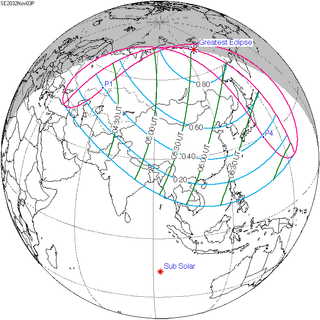Solar eclipse of November 3, 2032
| Solar eclipse of November 3, 2032 | |
|---|---|
| Type of eclipse | |
| Nature | Partial |
| Gamma | 1.0643 |
| Magnitude | 0.8554 |
| Maximum eclipse | |
| Coordinates | 70°24′N 132°36′E / 70.4°N 132.6°E |
| Times (UTC) | |
| Greatest eclipse | 5:34:13 |
| References | |
| Saros | 153 (10 of 70) |
| Catalog # (SE5000) | 9580 |
A partial solar eclipse will occur at the Moon's ascending node of orbit on Wednesday, November 3, 2032, with a magnitude of 0.8554. A solar eclipse occurs when the Moon passes between Earth and the Sun, thereby totally or partly obscuring the image of the Sun for a viewer on Earth. A partial solar eclipse occurs in the polar regions of the Earth when the center of the Moon's shadow misses the Earth.
Images[edit]
Related eclipses[edit]
Eclipses of 2032[edit]
- A total lunar eclipse on April 25, 2032.
- An annular solar eclipse on May 9, 2032.
- A total lunar eclipse on October 18, 2032.
- A partial solar eclipse on November 3, 2032.
Metonic[edit]
- Preceded by: Solar eclipse of January 14, 2029
- Followed by: Solar eclipse of August 21, 2036
Tzolkinex[edit]
- Preceded by: Solar eclipse of September 21, 2025
- Followed by: Solar eclipse of December 15, 2039
Half-Saros[edit]
- Preceded by: Lunar eclipse of October 28, 2023
- Followed by: Lunar eclipse of November 8, 2041
Tritos[edit]
- Preceded by: Solar eclipse of December 4, 2021
- Followed by: Solar eclipse of October 3, 2043
Solar Saros 153[edit]
- Preceded by: Solar eclipse of October 23, 2014
- Followed by: Solar eclipse of November 14, 2050
Inex[edit]
- Preceded by: Solar eclipse of November 23, 2003
- Followed by: Solar eclipse of October 13, 2061
Triad[edit]
- Preceded by: Solar eclipse of January 3, 1946
- Followed by: Solar eclipse of September 5, 2119
Solar eclipses of 2029–2032[edit]
This eclipse is a member of a semester series. An eclipse in a semester series of solar eclipses repeats approximately every 177 days and 4 hours (a semester) at alternating nodes of the Moon's orbit.[1]
Note: Partial solar eclipses on January 14, 2029 and July 11, 2029 occur on the previous lunar year eclipse set.
| Solar eclipse series sets from 2029 to 2032 | ||||||
|---|---|---|---|---|---|---|
| Descending node | Ascending node | |||||
| Saros | Map | Gamma | Saros | Map | Gamma | |
| 118 | June 12, 2029 Partial |
1.29431 | 123 | December 5, 2029 Partial |
-1.06090 | |
| 128 | June 1, 2030 Annular |
0.56265 | 133 | November 25, 2030 Total |
-0.38669 | |
| 138 | May 21, 2031 Annular |
-0.19699 | 143 | November 14, 2031 Hybrid |
0.30776 | |
| 148 | May 9, 2032 Annular |
-0.93748 | 153 | November 3, 2032 Partial |
1.06431 | |
Saros 153[edit]
This eclipse is a part of Saros series 153, repeating every 18 years, 11 days, and containing 70 events. The series started with a partial solar eclipse on July 28, 1870. It contains annular eclipses from December 17, 2104 through May 26, 2970. There are no hybrid or total eclipses in this set. The series ends at member 70 as a partial eclipse on August 22, 3114. Its eclipses are tabulated in three columns; every third eclipse in the same column is one exeligmos apart, so they all cast shadows over approximately the same parts of the Earth.
The longest duration of annularity will be produced by member 38 at 7 minutes, 1 seconds on September 5, 2537. All eclipses in this series occur at the Moon’s ascending node of orbit.[2]
| Series members 1–19 occur between 1870 and 2200: | ||
|---|---|---|
| 1 | 2 | 3 |
 July 28, 1870 |
 August 7, 1888 |
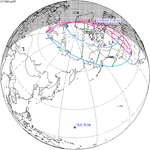 August 20, 1906 |
| 4 | 5 | 6 |
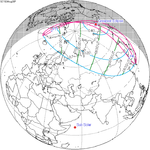 August 30, 1924 |
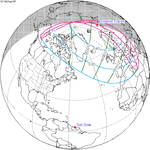 September 10, 1942 |
 September 20, 1960 |
| 7 | 8 | 9 |
 October 2, 1978 |
 October 12, 1996 |
 October 23, 2014 |
| 10 | 11 | 12 |
 November 3, 2032 |
 November 14, 2050 |
 November 24, 2068 |
| 13 | 14 | 15 |
 December 6, 2086 |
 December 17, 2104 |
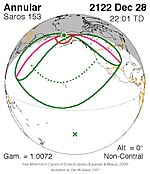 December 28, 2122 |
| 16 | 17 | 18 |
 January 8, 2141 |
 January 19, 2159 |
 January 29, 2177 |
| 19 | ||
 February 10, 2195 | ||
Metonic series[edit]
The metonic series repeats eclipses every 19 years (6939.69 days), lasting about 5 cycles. Eclipses occur in nearly the same calendar date. In addition, the octon subseries repeats 1/5 of that or every 3.8 years (1387.94 days). All eclipses in this table occur at the Moon's ascending node.
| 21 eclipse events, progressing from south to north between June 10, 1964, and August 21, 2036 | ||||
|---|---|---|---|---|
| June 10–11 | March 27–29 | January 15–16 | November 3 | August 21–22 |
| 117 | 119 | 121 | 123 | 125 |
 June 10, 1964 |
 March 28, 1968 |
 January 16, 1972 |
 November 3, 1975 |
 August 22, 1979 |
| 127 | 129 | 131 | 133 | 135 |
 June 11, 1983 |
 March 29, 1987 |
 January 15, 1991 |
 November 3, 1994 |
 August 22, 1998 |
| 137 | 139 | 141 | 143 | 145 |
 June 10, 2002 |
 March 29, 2006 |
 January 15, 2010 |
 November 3, 2013 |
 August 21, 2017 |
| 147 | 149 | 151 | 153 | 155 |
 June 10, 2021 |
 March 29, 2025 |
 January 14, 2029 |
 November 3, 2032 |
 August 21, 2036 |
References[edit]
- ^ van Gent, R.H. "Solar- and Lunar-Eclipse Predictions from Antiquity to the Present". A Catalogue of Eclipse Cycles. Utrecht University. Retrieved 6 October 2018.
- ^ "NASA - Catalog of Solar Eclipses of Saros 153". eclipse.gsfc.nasa.gov.
External links[edit]
- Earth visibility chart and eclipse statistics Eclipse Predictions by Fred Espenak, NASA/GSFC

